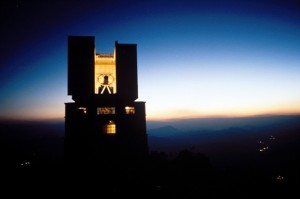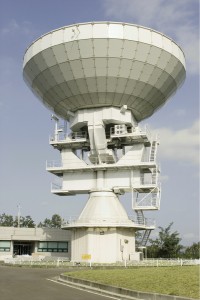
14 meter millimeter-wave radio telescope at the Taeduk Radio Astronomy Observatory. Photo courtesy Korea Astronomy Observatory.
A long time ago, in a galaxy far, far away, I was a contributing editor to a Korean-American cultural magazine. I’ve been meaning to dust off my language skills to do some research on the current state of observatories in South Korea, but every time I get started, I’m put off by how frequently academic and popular articles focus on Cheomsongdae observatory, built in 632-647 CE, rather than on contemporary developments. I suppose there’s nothing inherently wrong with that, but it seems a bit Orientalist to me, implying astronomy in Korea somehow stopped progressing during the Silla Dynasty period.
When my twitter feed lit up last night with news of Kim Jong-il’s demise, I began contemplating the state of astronomy in Korea again. It’s true the discipline went through some tough times during the twentieth century. For instance, during the Japanese occupation (1905-1945), Koreans weren’t allowed to be astronomers.[1] Obviously, there’s not much I can say about astronomy in North Korea following the conclusion of WWII, other than it must be amazing to look up at the night sky there, since there’s so little light pollution. In South Korea, astronomy as an academic field was slow to grow. The first bachelor of science program was founded in 1958 at Seoul National University; the second began about ten years later at Yongsei University. The Korean Astronomical Society was founded in 1965 and joined the International Astronomical Union (IAU) in 1973.[2] The Korea Astronomy and Space Science Institute (KASI), the national astronomy research institute of South Korea, was established in 1974.
I mention KASI for a reason. Although there are now other institutions and professional astronomical organizations in South Korea, KASI in particular turns the popular conception of Korean astronomy as an “ancient science” on its head. The research initiatives at KASI are numerous and diverse. KASI-supported observations started in 1978 with a 61-cm reflecting telescope at the Sobaeksan Optical Astronomy Observatory (SOAO). From there, it expanded into radio astronomy, founding the Taeduk Radio Astronomy Observatory (TRAO) in 1985. TRAO continues to operate with a 14 meter millimeter-wave radio telescope. In 1996, Bohyunsan Optical Astronomy Observatory (BOAO) was opened with the largest optical telescope in the country and in 2009, South Korea moved to join the Giant Magellan Telescope initiative.
KASI opened the 21st century with one of my favorite projects, the Korean VLBI Network KVN Group. Return visitors to this site may remember my obsession with the NRAO Very Long Baseline Array. A comparable scheme, KVN is the first Very Long Baseline Interferometer facility in Korea, consisting of three 21 meter radio telescopes, erected in Seoul-Yonsei University, Ulsan-Ulsan University, and Jeju-Tamna University. The maximum baseline length of the KVN is considerably shorter than that of the VLBA (compare 5,000 miles with the 480 km line between Seoul and Jeju).[3] However, KVN can be used in conjunction with Japanese and Chinese VLBI networks to form the East Asian VLBI network (EAVN), which is expected to be comparable to the VLBA in spatial resolution, sensitivity, and imaging fidelity.
This post really doesn’t have much to do with North Korea, does it? It’s wrong to envy their dark skies, I know, but it would be nice to have a decent view of the Milky Way for a change.
—————-
[1] I. S. Nha, “Astronomy in Korea,” The Third Pacific Rim Conference on Recent Development on Binary Star Research. Proceedings of a conference sponsored by Chiang Mai University, Thai Astronomical Society and the University of Nebraska-Lincoln held in Chiang Mai, Thailand, 26 October -1 November 1995. ASP Conference Series, Vol. 130, 1997, ed. Kam-Ching Leung, p. 313.
[2] Ibid., 313. North Korea joined the IAU separately in 1961 (see proceedings from the IAU XIth General Assembly, Berkeley, 1961). For the record, the IAU reported that North Korea “may be opening up to the rest of the world” in the 2008 Informational Bulletin no. 102 (see p. 75).
[3] Kiyoaki Wajima, Hyun-Goo Kim, Seog-Tae Han, Duk-Gyoo Roh, Do-Heung Je, Se-Jin Oh, Seog-Oh Wi, and Korean VLBI Network Group, “Korean VLBI Network: the First Dedicated Mm-Wavelength VLBI Network in East Asia,” XXVIIIth General Assembly, International Union of Radio Science (URSI), New Delhi, October 2005.

